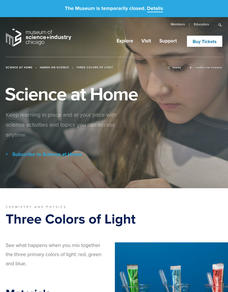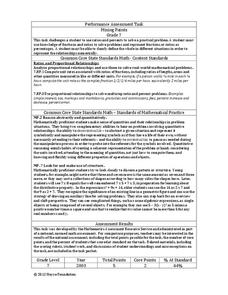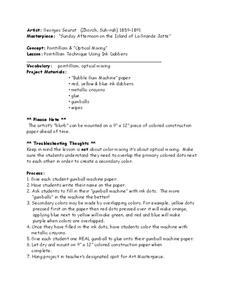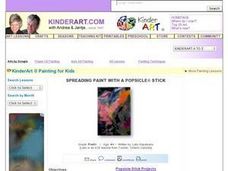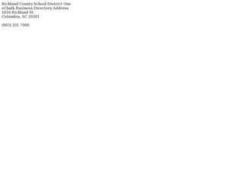PBS
Curious George: Water Drops
A short video features Curious George playing with pots filled with colored water. Scholars then take to colored water with eye droppers and observation skills. They examine what happens to water drops when dropped from different...
Museum of Science
Three Colors of Light
It only takes three colors. Using three-colored glow sticks, pupils observe what happens when colors of light mix together. Learners use the material from a red, green, and blue glow stick to mix together. By mixing small amount of the...
Noyce Foundation
Mixing Paints
Let's paint the town equal parts yellow and violet, or simply brown. Pupils calculate the amount of blue and red paint needed to make six quarts of brown paint. Individuals then explain how they determined the percentage of the brown...
North Birmingham Academy
Color Theory
What better way to learn about colors than by coloring? Starting with the primary colors, young artists follow written prompts to shade in various rectangles and a color wheel to show complementary colors, tints and shades, and more.
Curated OER
Pointillism Technique Using Ink Dabbers
A gumball machine art project is a great way to learn about optical mixing in a study of pointillism and Georges Seurat. Kids create their own masterpieces and learn about primary and secondary colors in the process.
Art Institute of Chicago
Color Combinations
Explore color through an examination of pointillism and light. Class members view Georges Seraut's famous painting on a computer, zooming in and out to see the details and effects of the technique. They then cover how light and color are...
Curated OER
Emotion Painting
Budding artists explore the nature of emotion through artistic expression. They discuss feelings, colors, line, and design, mix colors and then create an emotive piece that expresses a singular emotion. There are three cross-curricular...
Curated OER
Shaping the Color Wheel
When you paint you almost always use color. Budding artists explore the color wheel, color vocabulary, and painting techniques. They discuss and practice mixing colors, then paint a color wheel for personal reference.
Curated OER
Sponge Painting Flowers
Explore the shapes and colors of spring with a flower themed painting project. Included here are a list of materials and the instructions needed to execute an art lesson on sponge painting flowers. Tip: Use in conjunction with a flower...
Curated OER
Color the Snow
Are your teaching in a cold and snowy environment? If so, then try out this fun activity with your class. You mix a variety of colors in large jars to show learners the difference between primary and secondary colors, then let them mix...
Curated OER
Spreading Paint with a Popsicle Stick
This one is for the pre-K jet-set. They hone their observation and listening skills as they use Popsicle sticks to apply paint to wax paper. They view how the colors blend and mix together as they move the stick around on the paper.
Curated OER
Tissue Painting
Let's make colors! Your class will participate in a creative art project that introduces them to the concept of color blending and allows them to discover color combinations through exploration, trail, and error. First, the teacher will...
Curated OER
Mixing Colors
In this science learning exercise, students drop food coloring into a glass of water. Students mix different colors to create new colors.
Curated OER
Mixing Colors with Corn Syrup and Food Coloring
Anyone who has worked with small children know that color identification and color mixing can be fun! This simple idea has a lot of potential. It suggests to mix food coloring with corn syrup to provide an opportunity for color mixing...
Curated OER
Mouse Painting (Color Mixing)
After reading the story Mouse Paint by Ellen Stoll Walsh, little ones make a mouse painting of their own. They discuss mixing colors, painting, and the story, then they "dance" with their fingers through puddles of paint.
Curated OER
Two Layer Painting
With a little extra tag board and some tempera paint, learners can explore warm and cool colors. They create a two layered drip painting where they focus on mixing both cool and warm colors to achieve a fascinating effect.
Curated OER
Tissue Paper Butterfly
Creating butterfly art is as simple as 1-2-3. Kids cut coffee filters into butterfly shapes. Next, they wet and place squares of tissue paper onto the filters. Fifteen minutes later, they lift the tissue to reveal a colorful pattern...
Curated OER
Cornmeal with Powder Paint
Pre schoolers use art to build observational skills and eye-hand coordination. They squeeze art into a ribbon like shape on their paper, then sprinkle cornmeal and powder paint over it. They watch as water is sprayed on top of the...
Curated OER
The Color Wheel
Hand out this nifty resource to make your next instructional activity on the color wheel a snap. It is a picture of the color wheel alongside a description of primary, secondary, and mixing colors. Great for artists of any age.
Curated OER
Mix It Up : Colors
Fifth graders make predictions of the resulting colors when colors are mixed. In this colors instructional activity, 5th graders discuss vocabulary related to mixing colors. Students are asked to paint a picture of five colors from two...
Curated OER
Mixing Colors with "Little Blue and Little Yellow"
Students mix colors to make new colors. In this color mixing lesson, students listen to Leo Lionni's Petit Bleu et Petit Jaune, before retelling the beginning, middle, and end of the story. They watch as the teacher mixes food coloring...
Curated OER
Learning Secondary Colors
Students identify secondary colors. In this visual arts lesson, students predict what color will be made when two colors are mixed. Students create their own painting using secondary colors and write about their painting in their journals.
Curated OER
Mixing Colors
Students understand why we see various colors. For this mixing colors lesson, students experiment with different food coloring to explore how colors are made. Students record on a data sheet the colors they see.
Curated OER
Edible Color Wheels
Students create an edible color wheel using cookies and frosting. They mix tints into frosting to simulate the color of the color wheel.



